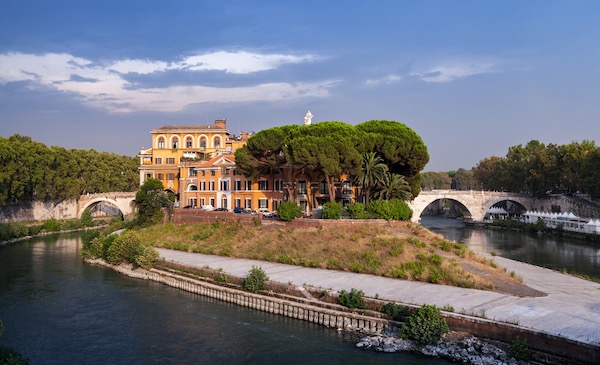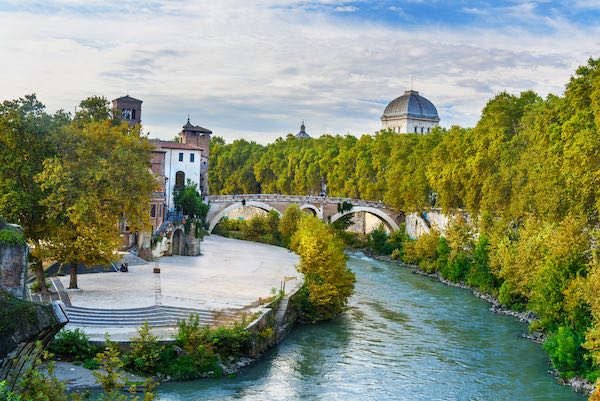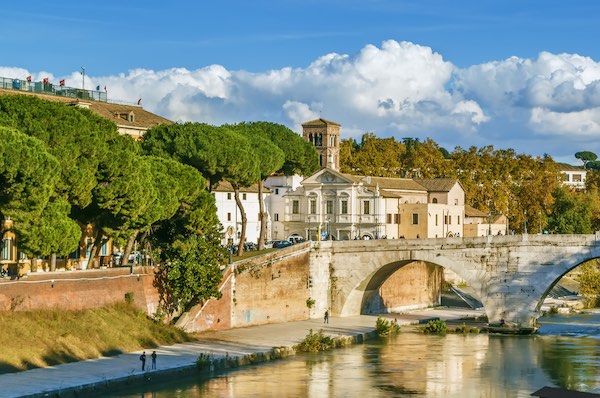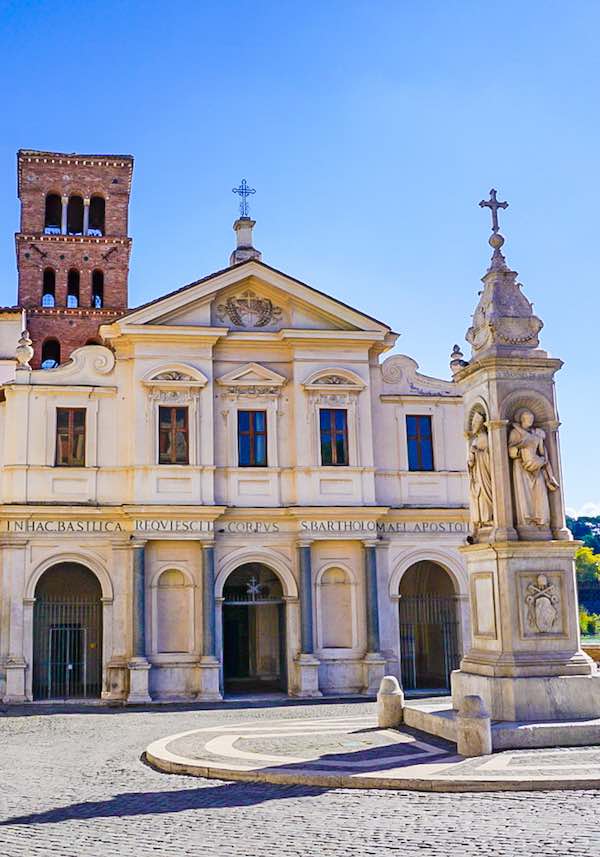All you need to know about the Tiber Island (Isola Tiberina), Rome island: where it is, how to visit, what to see, its history and significance.
Tiber Island in Rome (Isola Tiberina) is a fascinating place to visit.
Located in the city center, between the Jewish Ghetto and Trastevere, Tiber Island is beautiful and and a fantastic place to learn about ancient Roman legends and myths.

Rome island is in a central location but outside the most common tourist tracks. If you have more than a couple of days in Rome, however, it is worth seeing.
Today, I share interesting facts and info about the Tiberina Island, including the myths about its origin, where it is and how to visit.
Please note: this post contains affiliate links and, should you make a purchase through them, we might make a small commission.
Facts about Tiber Island, Rome’s island
The Tiber island in Rome is called Isola Tiberina = Tiber island.
In Italian: Isola = island and Tiberina = of the river Tiber.
Isola Tiberina is in the section of the Tiber that crosses Rome City center.
The closest Rome landmarks are the Synagogue, the Jewish Quarter (Ghetto of Rome) and Marcellus’ Theater on one side of the river and Piazza in Piscinula, in Trastevere, on the other.
The island is a natural feature and geologists have identified a very ancient nucleus of volcanic rock at its base.
However, the Tiber Island was so important for ancient Romand that they quickly worked on it and transformed it into a work of art.
As you look at it from the river quays, you will quickly notice what make this island special: the island has the shape of a boat and has a clearly distinguishable pointy front and, in origin, an obelisk as main mast.

This shape is connected to the ancient legend that tells us about the island’s origin and significance for ancient Romans (see below)
The island is about 300 mt long and 90mt wide.
Map of Isola Tiberina – Tiber Island Map
The legends of the origin of the Tiber Island
Ancient Roman legends tell us about the mythological origins of the island though two legends.
The first one brings the origin of the Tiber Island to the times of the seven Kings of Rome.
According to this version of events, when the Romans kicked King Tarquinius Superbus out of power, they threw him and his belongings in the Tiber.
The king’s hay bales were so numerous the river couldn’t wash them away so an island was born!
This legend is charming however, it does’t seem to be supported by geology or historical sources.
The mention of Tarquinius Superbus places the origin of the island in the later years of the VI century while archaeologists believe the island was one of the reason why Rome was founded in this specific location.
Since Rome’s birthday is the 21st April 753 B.C., they believe the island is at least that much older.
Tiber Island is where two crucial Roman trade routes met: via Salaria and via Campana.
This location ensured easy movement between the two sides of the river and would have been a reason why the city on the Palatine was able to grow and thrive.
This makes geographical sense: the Palatine offered to the Romans the safety of a hilltop position and saluter air while the river and the islands prevented isolation and guaranteed connections with the rest of the world.
The second legend attached to the Tiber Island is fascinating as it explains how the island acquired its shape like a boat.
It also creates a connection between ancient beliefs and the presence of a hospital on it. This legend dates from the third century B.C.

According to this legend, the plague ravaged Rome in 291 BC.
To find respite, the Romans sent a ship to Epidaurus, in Greece, to pray and honor Esculapius, the Roman God of medicine (you can read here >>> all about Roman Gods and their equivalents in Greek Mythology).
While at the temple, a snake left the sacred area and found refuge on the ship: since the snake was the symbol of the God, the Romand interpreted it as a good omen and rushed back to the city.
While sailing beside the Tiber island, the snake jumped out of the boat and found refuge there.
The Romans took this as a religious sign: they rebuilt the island in the shape of a boat to remember the event and devoted to him a sanctuary in that very spot.
Since then, the Tiber Island has been sacred to medicine and still nowadays hosts an important hospital.
What is on Tiber Island: What to see on Tiberina Island
The Tiber Island is pretty to visit and has some interesting spots.
The first thing to notice is its shape: the best viewpoints are from the bridges of Rome closest to it and in particular Ponte Garibaldi and Ponte Palatino.
On the island, thing you should see are:
The Infamous Column (Colonna Infame): The so called ‘Colonna infame’ is a small column with carvings and a cross on top in the spot where the Roman has originally built the main mast of the Tiberina ship.
The columns owes its name to the fact that Papal Rome used to publicise the names of the miscreant not allowed participate in Easter Mass. This use remained current until 1870!
Fun fact: you can read more about the use of statues in Papal Rome in this article about Rome’s talking statues.

Church of San Bartolomeo Apostolo: where the temple of Aesculapius once stood we know see the Church of S. Bartolomeo Apostolo.
Historical sources tells us that, in 997 AD Emperor Otto III built here a church to honor St Adalberto of Prague, using the ancient temple as foundation to the new one (this was common practice in Rome and the reason for so many Rome underground attractions).
In 1180 the church acquired the body of St. Bartholomew Apostle and changed its name accordingly.
The church went through several changes and now has a beautiful baroque facade and a stunning bell tower from the Middle Ages (X century AD).
The interior is also worth seeing and hosts a container in porphyry with the relics of St Bartholomew, a carved ceiling with sacred scenes connected with the life of St Francis and St Bartholomew and the ancient well.
It is worth noticing the carving and inscription on it that reads: OS PU – TEI S(AN)C(T)I – CIR CU(N)DANT – ORBE ROTANTI the saints in circle around the mouth of the well.
The connection with the original temple was never lost.
The well of the church, already in use in Roman times, was considered sacred and the water used as having healing powers.
However, this use of sacred water came quickly to an end when the pollution made it poisonous rather than healing!
The well has been closed ever since and still is.
The large building on the Tiber island is the hospital Fatebenefratelli.
The hospital has a small church built on top of another ancient temple, that of Iuppiter Iurarius (Jupiter of the oaths), remember by a mosaic found here.
The church is called S.Giovanni Calibita and legend says that it is where Clemens II was nominated Pope in the IX century.
The hospital is in use and one of the most important hospitals in Rome.
Torre della Pulzella – On the island side of ponte Fabricio stands a tall tower called Torre della Pulzezza (tower of the young girl).
The tower takes its name from the. sculpture of a female head dating from the I century A.D. and worked as residence for important Roman families such as Pierleoni and Caetani.

Why is Tiber Island important
Tiber Island is important for several reasons.
One is its role in ensuring the prosperity and growth of Ancient Rome and another is more recent yet very significant.
Fatebenefratelli Hospital is connected with a meaningful story, dating from the 1940s.
At that time, under Nazi rule, the jews of Rome started falling ill with a mysterious cough that doctors named Syndrome K.
Due to this cough, they would be admitted into hospital and kept in isolation as, according to their medical records, ‘highly contagious’.
This illness was, however, fake.
It was invented by Dr Ossicini and Dr Borromeo as a way to protect the Jews from prosecution, effectively offering them shelter at that most dangerous time.
Borromeo is recognised in the great Rome Synagogue as ‘Righteous Among the Nations’.
Tiber Island Rome guide: restaurants and entertainment
Nowadays, Isola Tiberina is a popular destination for dinners out and summer events. Here you can enjoy:
Sora Lella: a Rome institution, this is a fantastic Rome trattoria with fantastic dishes of the roman tradition.
Tiberino, popular for aperitivo as well as his excellent traditional Roman fare.
Isola del Cinema: a summer even with outdoor movie screenings.
Estate Romana -a popular summer events that brings to the island pop up bars, food stall and play areas (think fussball, ping pong, board games).
How to visit Tiber island
The Tiberi island is free and easy to visit.
You access it via two bridges: ponte Fabricio and ponte Cestio, which connect it respectively with Rome city center and Trastevere, the river tiber right bank.
The visit to the island only takes a few minutes however, guided tours such as this one include it and can be worth taking if you want to learn a little more about this Rome hidden gem.
Buses do not serve Isola Tiberina but leave you nearby. All buses serving Largo di Torre Argentina leave you a short walk from the Island.
Best hotel close to Tiber Island
There are no hotels on Tiber Island. However, there are several close to it, on either side of the River Tiber.
Some you may enjoy are:
Casa Monticelli (two locations), delighful self catering apartments sleeping up to six people.
Hotel Monte Cenci, 4 star boutique hotel in Rome City center, in a charming street close to the river, the Ghetto and all main Rome attractions.
47 Boutique hotel, a stunning hotel with incredible rooftop terrace (one of the best in Rome) and elegant rooms, some interconnecting.
I hope you enjoyed this quick guide to Rome’s Island and it helped you plan your visit. Safe travel planning!
